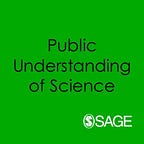Creative (Climate) Communications: Productive Pathways for Science, Policy and Society
Review by Brigitte Nerlich
Throughout the book good advice is given about how to communicate, with a focus on becoming smarter, rather than louder or scarier.
Max Boykoff’s work on climate change communication has inspired me for many years, so I was looking forward to reading this book, which, as the author says in a recent interview, “explores the effectiveness of certain storytelling techniques and ways of discussing climate change in the hopes that productive communication around the topic will lead to more constructive engagement”.
The book does that. There are two buts, however. The topic of the book was quite hot when it was written. In the meantime, things have changed. Climate change is no longer a distant and abstract issue (as still alleged on p. 28 and p. 51) and climate change communication has become part of new forms of climate change action, indeed a whole new climate movement. Creative communication is still needed, but the context in which it can be deployed is changing rapidly. The book is about creativity in communication, but it is, itself, written in a very traditional academic style, including a profusion of scholarly references. Having said that, as a summary of the present state of knowledge regarding (creative) climate change communication, the book is a great scholarly reference work.
The chapters mix scholarly discussions of the issue of intended or perceived audiences (chapter 1), the value of story-telling (chapter 2), the information-deficit model (chapter 3), ways of knowing (chapter 4), consensus messaging (chapter 5), science, advocacy and activism (chapter 6), experimentation (chapter 7), the role of young people (chapter 8) with examples of creative climate change communication, including comedy, fine art, performance art, videos, TV, dance, conversation and much more.
In chapter 4, for example, embedded in discussions of emotions, imagery and learning, we find advice on how to use humour and comedy to provide experiential access to climate change. After dipping into Foucault, Aristophanes, etc., examples like The Daily Show and Sizzle: A Global Warming Comedy (p. 106) are discussed. Chapter 5 showcases the project ‘More than scientists’, in which scientists try to show through videos and stories that they are concerned parents, citizens, etc., working together with other concerned parties in averting the worst impacts of climate change.
Chapter 7 presents examples of creative forms of communication such as Connect4Climate, Serious Games or Climojis; there is even a short mention of Clifi (Climate Fiction), amongst many more wonderful examples. From this, Boykoff develops five rules of the road worth exploring. These examples are fascinating, but the reader will find it difficult to dig them out of the densely packed chapters (the chapter and section titles are witty but don’t provide much guidance).
It might have been better to start the book with great examples like the ‘Inside the Greenhouse’ project, so central to Boykoff’s work and to the book or take examples from a variety of countries, not just the US, so as to showcase the diversity of creativity — Germany and France, under Merkel and Macron, tackle climate change differently to the US and Trump — or perhaps contrast a successful project with an unsuccessful project or a project that backfired. And only then launch into a scholarly dissection of, say, the information-deficit model, audience segmentation, climate change contrarians, post-truth, cultural cognition and all the other talking-points of academic climate change communication research.
Throughout the book good advice is given about how to communicate, with a focus on becoming smarter, rather than louder or scarier. For example, we are told that “this ‘smartening up’ is a process of listening and adapting rather than one of winning an argument or talking people into something”. I’d add that this also includes accepting that you can’t really talk people out of something.
One aspect of climate change communication is not discussed and that is creative language use. Here scientists and policy advocates have been always ahead of their time from ‘greenhouse effect’, created by the scientist Alexander Graham Bell in 1917, to ‘carbon footprint’ and other ‘carbon’ words which have structured policies from around 2005 onwards. Now a whole new language of ‘crisis’, ‘emergency’ and even ‘extinction’ is emerging. We have to see how this works out in the future.
When I was reading this book, the global climate strikes happened and I saw a tweet by Ed Maibach, climate communication expert par excellence: “This #ClimateStrikeDenver photo of @boykoff & his mom w/@BetoORourke made my day for many reasons, including Max’s shirt with the Big Five key beliefs about climate change (in 10 words): It’s real; it’s us; experts agree; it’s bad; there’s hope”.
Here we have creative climate change communication in action, combining science and politics, creative science communication and activism, displaying the facts and calling for action. Something like this photo and tweet could have been a good opening for this immensely but densely informative book dealing with the theory and practice of creative climate change communication.
Brigitte Nerlich is Emeritus Professor of Science, Language and Society at the University of Nottingham. She has a background in the humanities and social sciences and does research on how culture and language shape science and science communication, including climate change communication. She blogs at Making Science Public
